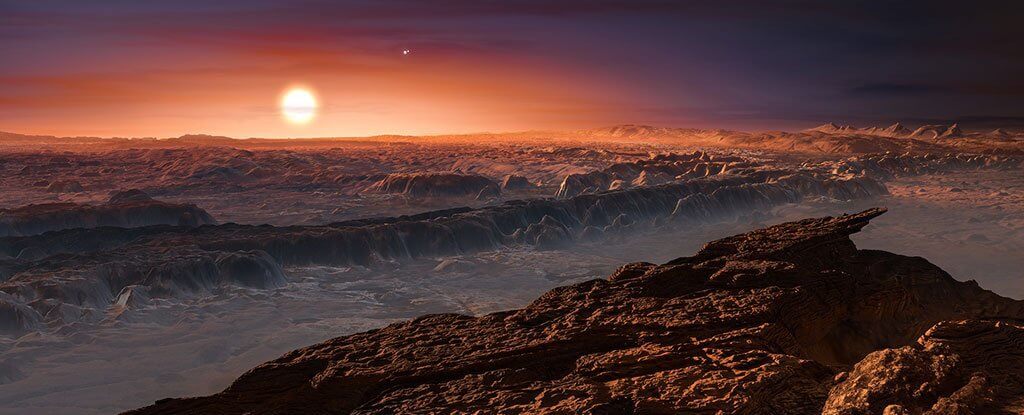
Scientists say that Proxima b – closest to our Solar system, earth – like planet is still could be inhabited, which gives us a hope that is literally under our side might be a world with conditions for maintaining the existence of extraterrestrial life.
The discovery of this planet has caused the strongest flurry of rave reviews in the scientific community and the media in the past year. Still, we brought a new world located in the habitable zone of their stars and also very close – just 4.2 light years away. Shortly thereafter, the scientific community began a debate on the topic ‘ potential for habitability. Both the one and the other cited logical arguments. A new simulation shows that the planet still capable of supporting a stable climate, potentially suitable for extraterrestrial life forms.
According to the simulations created by researchers from Exeter University, UK, Proxima b could have the conditions to support liquid water on its surface in a number of different orbital characteristics and depending on exactly how it revolves around its star (the scientists this is still certainly not found.)
We briefly recall what is this all about:
- Title: Proxima b.
- Affiliation: planet of the Proxima Centauri system.
- Object distance: 4.2 light years.
- Special characteristics: the terrestrial planets closest to the Solar system, located in the habitable zone of its star.
The assumption that the planet may be the only one in this system – only increases its value to scholars and researchers. Some of them even have ambitious plans related to use of this potentially habitable neighbor’s Land. Unfortunately, nobody can accurately answer the question of whether at Proxima b is life, so the only thing that remains for scientists is to actually try to guess based on the facts related to its already known characteristics, as well as its native system.
Previous attempts at analysis indicated that Proxima b can be covered with water, which immediately increases the probability of having life on it. Later, scientists expressed the assumption that the planet can be a completely naked, broken piece of stone, and the reason for that is the excessive activity of the star Proxima Centauri, the unforgivable proximity with which is “our” planet.
The level of hope “for a better future for humanity” reduced reports of scientists, published in February of this year. Researchers from NASA then announced that the stellar activity could burn the atmosphere of Proxima b, leaving her completely oxygen-free (of course, if the oxygen there ever were).
However, new research from Exeter University says that having a defined orbital characteristics, Proxima b could maintain “habitable kind and supportive water environment.”
Using the same modeling algorithms, which are commonly used to simulate the earth’s weather conditions, the team found that Proxima b could support the presence of water on the surface, if she had the same atmosphere as our Earth, or at least the atmosphere, which contained nitrogen and carbon dioxide.
“Our model, unlike others, is able to take into account the variability of emissions that the planet would have to experience according to its orbital characteristics. We found that under certain conditions, Proxima b would be able not only to maintain the water in liquid form on its surface, but to be inhabitable,” commented astrophysicist Nathan Maine.
There is an assumption that the exoplanet is in the tidal capture its star. In other words, she’s like the Moon is always directed from one side towards the Earth. Simulations show that under such conditions it will also be able to support liquid water, although to a lesser extent compared to if she could turn around during the orbital rotation around the star.
Their simulations, the scientists also carried out taking into account so-called orbital resonance with the figure 3:2. That is, when the planet rotates three full turns around itself during two orbital revolutions around the star. Mercury, first planet from the Sun, has the same orbital resonance, so scientists have suggested, if Proxima b has the same features, the water on its surface in this case can be even more. Thus light and heat generated by the star would be enough to ensure that the entire surface of the planet kept the temperature suitable for the water content in liquid form.
Of course, all this is only hypothetical speculation. But until then, until we can get to Proxima b closer, this kind of computer simulations remain our only source of food and for the assumptions related to the potential of its habitability. Moreover, at the moment, all the above assumptions are perhaps the most conclusive arguments in favor of this potential.
“Of course, direct observations of the planet might reveal to us much more information on the composition of its atmosphere, but now we have no such opportunity,” says Maine.
“After learning about the planet more, we could eliminate even more “free parameters” and, ultimately, to obtain a full picture of what Proxima b really is and what constitutes its surface”.
The controversy surrounding the potential habitability of the planet Proxima b continue
Nikolai Khizhnyak